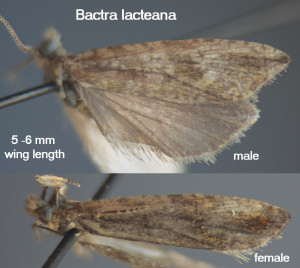Paul Kitchener posted the first Suffolk record of Bactra lacteana that was captured at the eastern edge of Dunich Forest on 14th August last year ( www.suffolkmoths.org.uk/blog/index.php/2015/11/12/5907/ ) On 5th August this year I collected two Bactra lacteana at my Abbey Farm site at Snape. They were taken home for identification as small indet tortricids. This process involves them being put into a tube possibly along with other specimens and have to survive the journey back home prior to temporary storage in the fridge before identification. My photos are therefore no match to the others referenced here! They were in fact identified by dissection one male and one female. Abbey Farm is an appropriate habitat for the species; wet meadow and reed-bed in abundance. The species is small for a Bactra. Forewing length is 5 to 6 mm where-as that of B. furfurana at that site is around 8 mm. These two species have similar genitalia features. The species shows two parallel dark dashes on the forewing just short of the apex. This is not always entirely clear. Otherwise the pattern is variable as with other Bactra. UKMoths shows a stridently marked individual ( http://www.ukmoths.org.uk/species/bactra-lacteana/ ). The images in Lepiforum include a specimen with orange/brown shading as seen on my female and to a slight extent on Paul’s specimen ( http://www.lepiforum.de/lepiwiki.pl?Bactra_Lacteana
One to look out for in any suitable location in Suffolk (Waveney Valley sites?)


This must be an overlooked species in the east of England – see map http://www.mothscount.org/uploads/1111a_Bactra_lacteana.png
Paul
I’ve got a possible in my collection of dissections for the winter from Bill Last from Harlow in Essex. Not seen any candidates at any of the sites I’ve been to this year have been looking out.
Good luck with this. I found the female one of the most difficult to dissect I have come across. The male is OK but the distinction from furfurana is slight. The moth size and the two dashes are most helpful.
Measured the forewing length at 6mm, and it seems to have 2 black dashes too so a good candidate. Looks like a male.